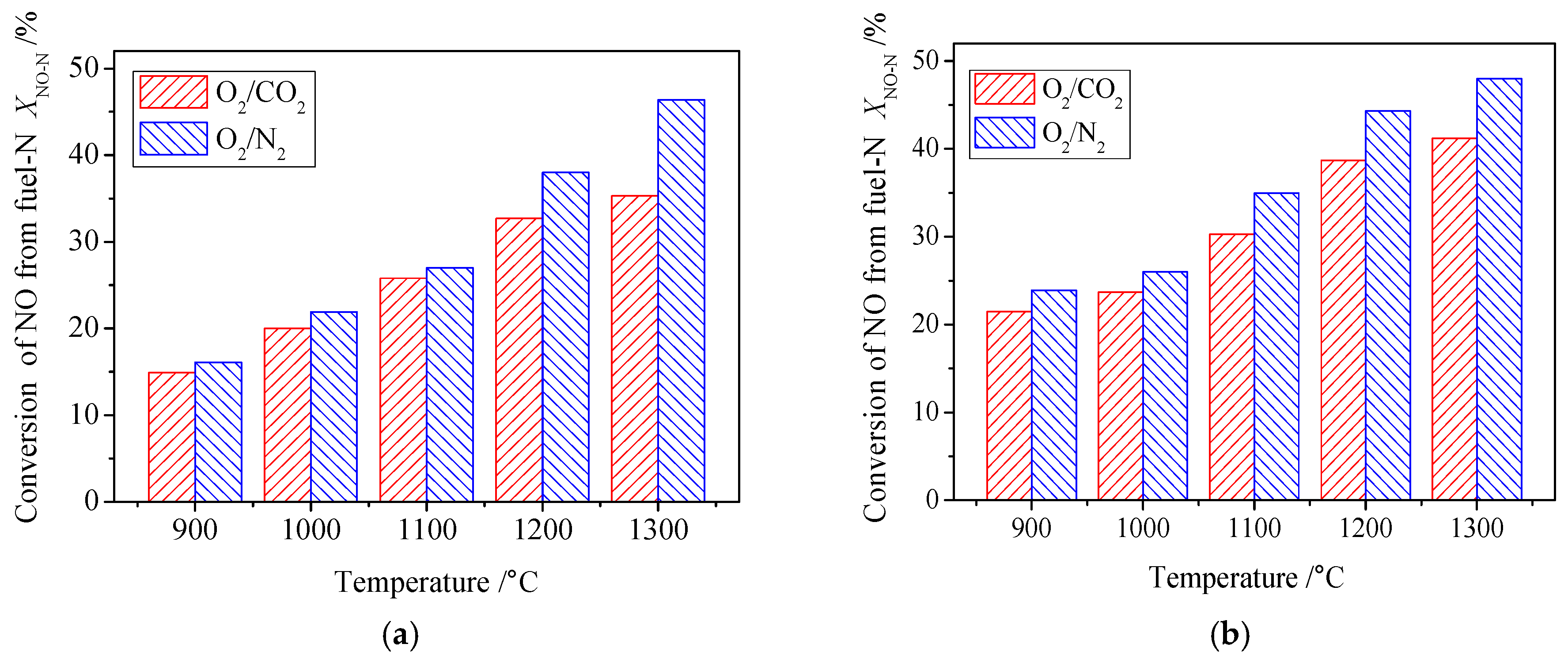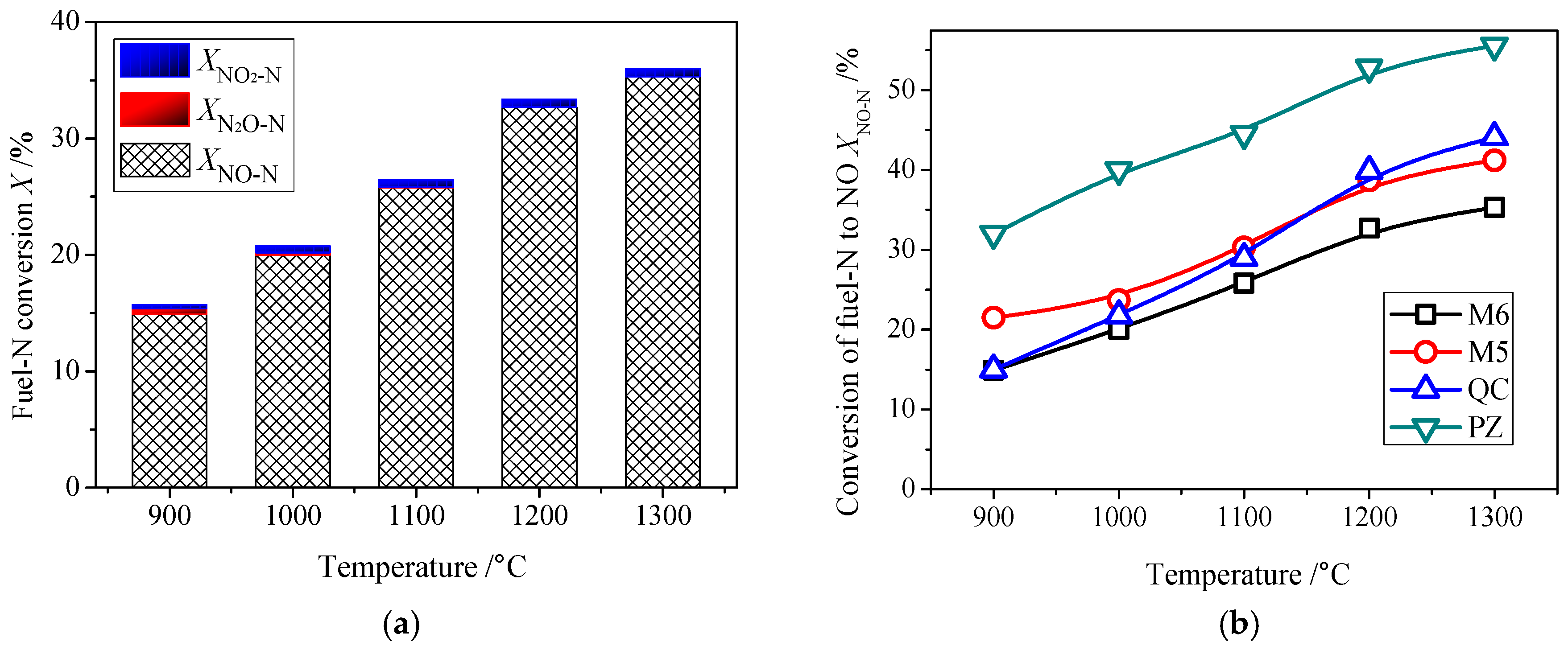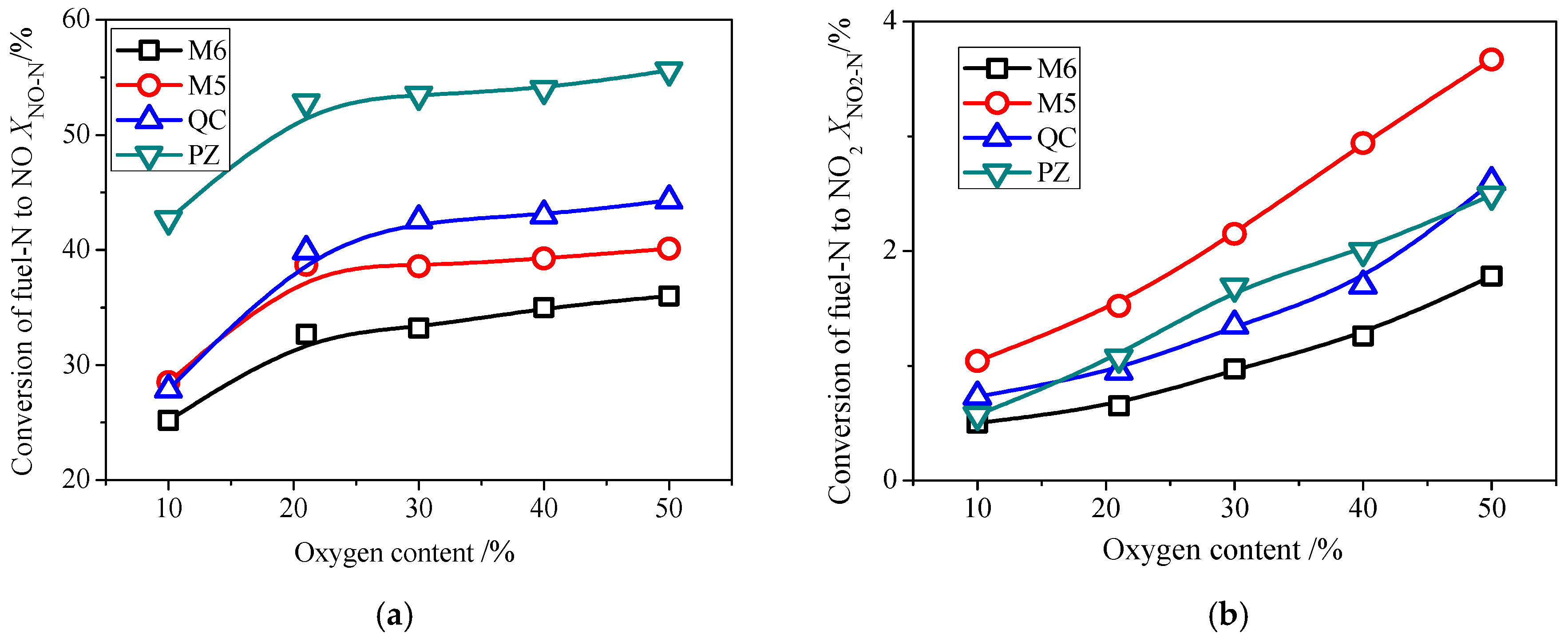Experimental Study on NOx Reduction in Oxy-fuel Combustion Using Synthetic Coals with Pyridinic or Pyrrolic Nitrogen
Abstract
:1. Introduction
2. Materials and Methods
2.1. Sample Preparation
2.2. Experimental Setup
3. Results
3.1. Influence of Combustion Atmosphere on the Oxidation of Different Nitrogen Functional Groups
3.2. The Effect of Combustion Temperature on the Formation of NOx
3.3. Comparison of the NO and NO2 Emissions with Oxygen Content
3.4. Particle Size Dependence of NO and NO2 Emission
3.5. Mineral Impacts on the Transformation of Fuel Nitrogen
4. Conclusions
Author Contributions
Funding
Acknowledgments
Conflicts of Interest
References
- Xin, H.H.; Wang, D.M.; Qi, X.Y.; Qi, G.S.; Dou, G.L. Structural characteristics of coal functional groups using quantum chemistry for quantification of infrared spectra. Fuel Process. Technol. 2014, 118, 287–295. [Google Scholar] [CrossRef]
- Xin, H.H.; Wang, D.M.; Qi, X.Y.; Zhong, X.X.; Ma, L.Y.; Dou, G.L.; Wang, H.T. Oxygen consumption and chemisorption in low-temperature oxidation of sub-bituminous pulverized coal. Spectrosc. Lett. 2018, 51, 104–111. [Google Scholar] [CrossRef]
- Jayaraman, K.; Kok, M.V.; Gokalp, I. Pyrolysis, combustion and gasification studies of different sized coal particles using TGA-MS. Appl. Therm. Eng. 2017, 125, 1446–1455. [Google Scholar] [CrossRef]
- Jayaraman, K.; Kok, M.V.; Gokalp, I. Thermogravimetric and mass spectrometric (TG-MS) analysis and kinetics of coal-biomass blends. Renew. Energy 2017, 101, 293–300. [Google Scholar] [CrossRef]
- Mathews, J.P.; Miller, B.G.; Song, C.S.; Schobert, H.H.; Botha, F.; Finkleman, R.B. The EBB and flow of US coal research 1970-2010 with a focus on academic institutions. Fuel 2013, 105, 1–12. [Google Scholar] [CrossRef]
- Suresh, M.; Reddy, K.S.; Kolar, A.K. Thermodynamic analysis of a coal-fired power plant repowered with pressurized pulverized coal combustion. Proc. Inst. Mech. Eng. Part A 2012, 226, 5–16. [Google Scholar] [CrossRef]
- Elfeky, A.Y.; Abdelkhalek, M.F.; Kamal, M.M. Pulverized coal combustion with opposing/cross-flow methane/air mixtures. Proc. Inst. Mech. Eng. Part A 2014, 228, 688–707. [Google Scholar] [CrossRef]
- Kok, M.V. Carbon capture and storage: Current perspectives, re-use activities, and future prospects in Turkey. Energy Sources Part A 2015, 37, 1979–1987. [Google Scholar] [CrossRef]
- Li, W.; Li, S.Y.; Xu, M.X.; Wang, X. Study on the limestone sulfation behavior under oxy-fuel circulating fluidized bed combustion condition. J. Energy Inst. 2018, 91, 358–368. [Google Scholar] [CrossRef]
- Li, W.; Xu, M.X.; Li, S.Y. Calcium sulfation characteristics at high oxygen concentration in a 1MW(th) pilot scale oxy-fuel circulating fluidized bed. Fuel Process. Technol. 2018, 171, 192–197. [Google Scholar] [CrossRef]
- Mansouri, M.T.; Mousavian, S.M. Exergy-based analysis of conventional coal-fired power plant retrofitted with oxy-fuel and post-combustion CO2 capture systems. Proc. Inst. Mech. Eng. Part A 2012, 226, 989–1002. [Google Scholar] [CrossRef]
- Jayanti, S.; Saravanan, V.; Sivaji, S. Assessment of retrofitting possibility of an Indian pulverized coal boiler for operation with Indian coals in oxy-coal combustion mode with CO2 sequestration. Proc. Inst. Mech. Eng. Part A 2012, 226, 1003–1013. [Google Scholar] [CrossRef]
- Wall, T.; Liu, Y.; Spero, C.; Elliott, L.; Khare, S.; Rathnam, R.; Zeenathal, F.; Moghtaderi, B.; Buhre, B.; Sheng, C.; et al. An overview on oxyfuel coal combustion--State of the art research and technology development. Chem. Eng. Res. Des. 2009, 87, 1003–1016. [Google Scholar] [CrossRef]
- Toftegaard, M.B.; Brix, J.; Jensen, P.A.; Glarborg, P.; Jensen, A.D. Oxy-fuel combustion of solid fuels. Prog. Energy Combust. Sci. 2010, 36, 581–625. [Google Scholar] [CrossRef]
- Chen, L.; Yong, S.Z.; Ghoniem, A.F. Oxy-fuel combustion of pulverized coal: Characterization, fundamentals, stabilization and CFD modeling. Prog. Energy Combust. Sci. 2012, 38, 156–214. [Google Scholar] [CrossRef]
- Stanger, R.; Wall, T.; Spoerl, R.; Paneru, M.; Grathwohl, S.; Weidmann, M.; Schefflmecht, G.; McDonald, D.; Myohanen, K.; Ritvanen, J.; et al. Oxyfuel combustion for CO2 capture in power plants. Int. J. Greenh. Gas Control 2015, 40, 55–125. [Google Scholar] [CrossRef]
- Ipek, O.; Gurel, B.; Kan, M. Numerical analysis of oxy-coal combustion system burning pulverized coal mixed with different flue gas mass flow rates. J. Energy Eng. 2017, 143, 04016053. [Google Scholar] [CrossRef]
- Bu, C.S.; Gomez-Barea, A.; Leckner, B.; Chen, X.P.; Pallares, D.; Liu, D.Y.; Lu, P. Oxy-fuel conversion of sub-bituminous coal particles in fluidized bed and pulverized combustors. Proc. Combust. Inst. 2017, 36, 3331–3339. [Google Scholar] [CrossRef]
- Wang, W.K.; Bu, C.S.; Gomez-Barea, A.; Leckner, B.; Wang, X.Y.; Zhang, J.B.; Piao, G.L. O2/CO2 and O2/N2 combustion of bituminous char particles in a bubbling fluidized bed under simulated combustor conditions. Chem. Eng. J. 2018, 336, 74–81. [Google Scholar] [CrossRef]
- Mousavian, S.M.; Mansouri, M.T. Conceptual feasibility study of retrofitting coal-fired power plant with oxy-fuel combustion. Proc. Inst. Mech. Eng. Part A 2011, 225, 689–700. [Google Scholar] [CrossRef]
- Stadler, H.; Christ, D.; Habermehl, M.; Heil, P.; Kellermann, A.; Ohliger, A.; Toporov, D.; Kneer, R. Experimental investigation of NOx emissions in oxycoal combustion. Fuel 2011, 90, 1604–1611. [Google Scholar] [CrossRef]
- Ndibe, C.; Sporl, R.; Maier, J.; Scheffknecht, G. Experimental study of NO and NO2 formation in a PF oxy-fuel firing system. Fuel 2013, 107, 749–756. [Google Scholar] [CrossRef]
- Wang, C.; Du, Y.; Che, D. Study on N2O reduction with synthetic coal char and high concentration CO during oxy-fuel combustion. Proc. Combust. Inst. 2015, 35, 2323–2330. [Google Scholar] [CrossRef]
- Lei, M.; Huang, X.Z.; Wang, C.B.; Yan, W.Q.; Wang, S.L. Investigation on SO2, NO and NO2 release characteristics of Datong bituminous coal during pressurized oxy-fuel combustion. J. Therm. Anal. Calorim. 2016, 126, 1067–1075. [Google Scholar] [CrossRef]
- He, Y.Z.; Zheng, X.C.; Luo, J.H.; Zheng, H.F.; Zou, C.; Luo, G.Q.; Zheng, C.G. Experimental and numerical study of the effects of steam addition on NO formation during methane and ammonia oxy-fuel combustion. Energy Fuels 2017, 31, 10093–10100. [Google Scholar] [CrossRef]
- Xu, M.X.; Li, S.Y.; Wu, Y.H.; Jia, L.F.; Lu, Q.G. The characteristics of recycled NO reduction over char during oxy-fuel fluidized bed combustion. Appl. Energy 2017, 190, 553–562. [Google Scholar] [CrossRef]
- Ikeda, M.; Toporov, D.; Christ, D.; Stadler, H.; Forster, M.; Kneer, R. Trends in NOx during pulverized fuel oxy-fuel combustion. Energy Fuels 2012, 26, 3141–3149. [Google Scholar] [CrossRef]
- Lupianez, C.; Guedea, I.; Bolea, I.; Diez, L.I.; Romeo, L.M. Experimental study of SO2 and NOx emissions in fluidized bed oxy-fuel combustion. Fuel Process. Technol. 2013, 106, 587–594. [Google Scholar] [CrossRef]
- Lasek, J.A.; Glod, K.; Janusz, M.; Kazalski, K.; Zuwala, J. Pressurized oxy-fuel combustion: A study of selected parameters. Energy Fuels 2012, 26, 6492–6500. [Google Scholar] [CrossRef]
- Andersson, K.; Normann, F.; Johnsson, F.; Leckner, B. NO emission during oxy-fuel combustion of lignite. Ind. Eng. Chem. Res. 2008, 47, 1835–1845. [Google Scholar] [CrossRef]
- Alves, M.; Rosa, C.; Costa, M. Effect of the oxidizer composition on the CO and NOx emissions from a laboratory combustor operating under oxy-Fuel conditions. Energy Fuels 2013, 27, 561–567. [Google Scholar] [CrossRef]
- Sun, S.Z.; Cao, H.L.; Chen, H.; Wang, X.Y.; Qian, J.A.; Wall, T. Experimental study of influence of temperature on fuel-N conversion and recycle NO reduction in oxyfuel combustion. Proc. Combust. Inst. 2011, 33, 1731–1738. [Google Scholar] [CrossRef]
- Shaddix, C.R.; Molina, A. Fundamental investigation of NOx formation during oxy-fuel combustion of pulverized coal. Proc. Combust. Inst. 2011, 33, 1723–1730. [Google Scholar] [CrossRef]
- Duan, L.B.; Zhao, C.S.; Zhou, W.; Qu, C.R.; Chen, X.P. Effects of operation parameters on NO emission in an oxy-fired CFB combustor. Fuel Process. Technol. 2011, 92, 379–384. [Google Scholar] [CrossRef]
- Li, C.Z.; Buckley, A.N.; Nelson, P.F. Effects of temperature and molecular mass on the nitrogen functionality of tars produced under high heating rate conditions. Fuel 1998, 77, 157–164. [Google Scholar] [CrossRef]
- Wang, C.; Du, Y.; Che, D. Reactivities of coals and synthetic model coal under oxy-fuel conditions. Thermochim. Acta 2013, 553, 8–15. [Google Scholar] [CrossRef]
- Normann, F.; Andersson, K.; Leckner, B.; Johnsson, F. Emission control of nitrogen oxides in the oxy-fuel process. Prog. Energy Combust. Sci. 2009, 35, 385–397. [Google Scholar] [CrossRef]
- Zhu, Q.; Grant, K.A.; Thomas, K.M. The effect of Fe catalyst on the release of NO during the combustion of anisotropic and isotropic carbons. Carbon 1996, 34, 523–532. [Google Scholar] [CrossRef]
- Liu, Y.; Che, D. Releases of NO and its precursors from coal combustion in a fixed bed. Fuel Process. Technol. 2006, 87, 355–362. [Google Scholar] [CrossRef]
- Zhao, K.; Tan, H.; Zhou, Q.; Hui, S.; Xu, T.; Che, D. Experimental investigation on the oxidation rules of pyridine. J. Combust. Sci. Technol. 2004, 10, 392–395. [Google Scholar]
- Hayhurst, A.N.; Ninomiya, Y. Kinetics of the conversion of NO to N2 during the oxidation of iron particles by NO in a hot fluidised bed. Chem. Eng. Sci. 1998, 53, 1481–1489. [Google Scholar] [CrossRef]
- Gradoń, B.; Lasek, J. Investigations of the reduction of NO to N2 by reaction with Fe. Fuel 2010, 89, 3505–3509. [Google Scholar] [CrossRef]








| Coal Code | BET m2 g−1 | Fuel Ratio (w(FC)/w(V)) | Proximate Analysis | Ultimate Analysis | ||||||
|---|---|---|---|---|---|---|---|---|---|---|
| w(FC) | w(V) | w((A) | w(C) | w(H) | w(O) a | w(N) | w(S) | |||
| QC | 3.87 | 2.5 | 46.31 | 18.26 | 35.43 | 55.36 | 3.12 | 4.64 | 1.10 | 0.35 |
| PZ | 9.37 | 1.2 | 38.77 | 31.22 | 30.01 | 50.58 | 3.42 | 14.09 | 0.90 | 1.00 |
| M6 | 4.12 | 2.2 | 68.90 | 31.10 | 0.00 | 65.39 | 2.86 | 28.30 | 3.45 | 0.00 |
| M5 | 4.31 | 2.2 | 68.47 | 31.53 | 0.00 | 68.12 | 3.09 | 25.96 | 2.83 | 0.00 |
© 2018 by the authors. Licensee MDPI, Basel, Switzerland. This article is an open access article distributed under the terms and conditions of the Creative Commons Attribution (CC BY) license (http://creativecommons.org/licenses/by/4.0/).
Share and Cite
Wang, C.; Wang, P.; Zhao, L.; Du, Y.; Che, D. Experimental Study on NOx Reduction in Oxy-fuel Combustion Using Synthetic Coals with Pyridinic or Pyrrolic Nitrogen. Appl. Sci. 2018, 8, 2499. https://doi.org/10.3390/app8122499
Wang C, Wang P, Zhao L, Du Y, Che D. Experimental Study on NOx Reduction in Oxy-fuel Combustion Using Synthetic Coals with Pyridinic or Pyrrolic Nitrogen. Applied Sciences. 2018; 8(12):2499. https://doi.org/10.3390/app8122499
Chicago/Turabian StyleWang, Chang’an, Pengqian Wang, Lin Zhao, Yongbo Du, and Defu Che. 2018. "Experimental Study on NOx Reduction in Oxy-fuel Combustion Using Synthetic Coals with Pyridinic or Pyrrolic Nitrogen" Applied Sciences 8, no. 12: 2499. https://doi.org/10.3390/app8122499




